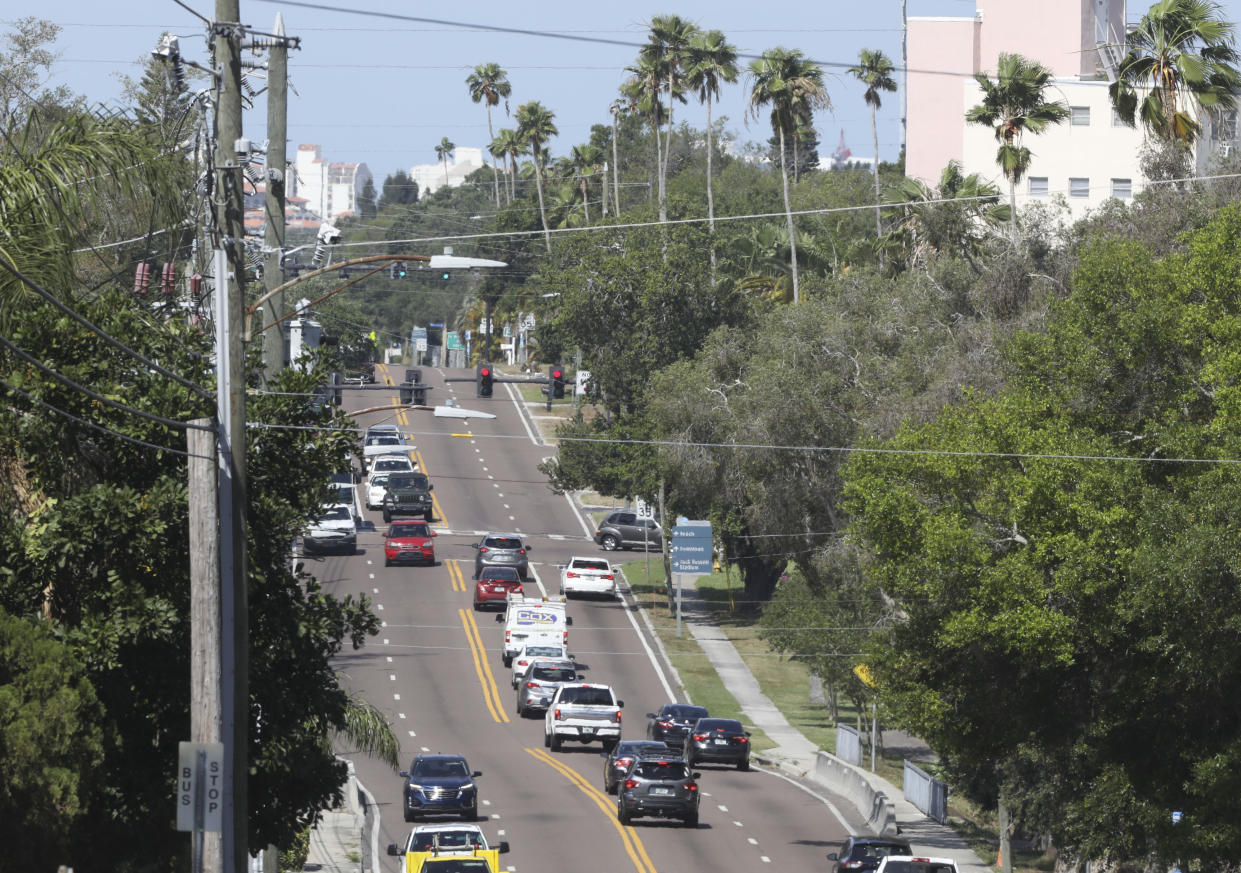Clearwater Council considers scaled-down improvements for Drew Street

CLEARWATER — The plan on the table for improving safety on one of the city’s main east-west corridors is not the version that received multiple approvals since 2018, was vetted through resident workshops and validated by state traffic studies.
But over the past two weeks, state transportation officials have formulated a scaled-back alternative that may be able to satisfy the political forces that derailed the original concept.
The City Council is scheduled to vote Thursday on whether to advance design work on a reconfiguration of Drew Street that does not include the lane elimination concept that the Florida Legislature delayed last year and three new City Council members elected in March opposed.
In comments during a work session Monday, or in interviews with the Tampa Bay Times, all five council members indicated they were supportive of the scaled-down plan as a solution for the dangerous corridor.
“This alternative proposes a compromise and helps us get started on some important improvements,” Mayor Bruce Rector told the Times.
The original concept proposed converting Drew Street from four travel lanes to two in the 2.3 miles between Osceola Avenue in downtown and Keene Road to the east, and adding a center turn lane for most of that portion. It included expanded sidewalks for pedestrians and cyclists and added mid-block crosswalks.
The alternative presented Monday focuses on improving intersections to reduce crashes. Without the space created with the lane elimination, it does not include the same sidewalk and crosswalk improvements. It includes a dedicated center turn lane for about 0.5 miles compared to the original 2-mile option. If approved Thursday, state officials said the plan would be tweaked in the design phase but will include:
Between Osceola and Myrtle avenues: converting the four travel lanes to two and adding a track on the north side for a two-way bicycle lane, wide sidewalk or on-street parking.
At the intersection with Myrtle Avenue: converting the inside westbound lane near the intersection into a dedicated left turn lane.
Between Myrtle Avenue and North Martin Luther King Jr. Ave: no change
Between North Martin Luther King Jr. Ave and Betty Lane: maintaining two travel lanes in each direction but widening the roadway on the north side to make space for a two-way center turn lane. At the intersection with North Missouri Avenue, adding a westbound left turn lane.
At the intersection with Betty Lane: adding an eastbound left-turn lane.
From Betty Lane to Keene Road: no change
The original plan included improvements for Drew Street east of Keene Road that never involved a lane elimination or controversy. Those changes, like wider bike lanes and additional pedestrian crossings, are preserved in the alternative concept.
The plan also includes reduced speed limits. Justin Hall, Florida Department of Transportation’s director of transportation development, told the council that officials are exploring ways to resolve the speeding problem, especially between Betty Lane and Keene Road. He said options such as speed feedback signs, pedestrian crossings and raised speed tables may be possible.
But there are also unknowns with the alternative concept. Hall said the road widening between North Washington Avenue and Betty Lane will require environmental permitting and could have yet-to-be-seen impacts on utilities, landscaping and drainage.
The road widening may also require money from the city to relocate underground utilities. In an email to city administrators last week, Assistant City Manager Dan Slaughter estimated the utility relocation could cost $12.8 million. But on Monday, he told the Times that was a worst-case estimate. Slaughter said actual costs will be confirmed in design and could be less.
The original Drew Street proposal did not require any city or county money and was covered by $20 million in mostly federal funds secured by Whit Blanton, executive director of the county’s transportation planning agency Forward Pinellas.
In an interview, Blanton said the alternative plan could be a way to improve Drew Street without losing the $20 million. He said the alternative does not go as far to address safety, but additions may be able to be implemented during design, such as sidewalk expansions and speed mitigation.
Since 2015, Drew Street between Osceola Avenue and Keene Road had seven fatalities, 1,586 crashes and 620 injuries — 55 of them serious injuries, according to county data.
A 2023 state study concluded the lane elimination concept would have reduced crashes by 57%, increased travel time by less than 30 seconds and diverted minimal cars to surrounding roads. But the new majority of council members elected in March doubted those findings and had concerns about traffic flow and impact on parallel roads.
Blanton and Hall said the updated plan focuses on improvements at the intersections where most of the crashes have been concentrated.
“I’m supportive of the plan moving forward because I think we all just want to move on and deliver a project that’s going to improve safety, and I think this will,” Blanton said.
For years, resident Mike Riordon has lobbied for the lane elimination concept on Drew Street and brought elected officials on walking tours to show how, in some areas, sidewalks are too narrow for a wheelchair. He said the alternative plan is a watered down version that doesn’t address some of the most dangerous areas for pedestrians and cyclists.
Beth Davis, who lives near Drew Street and also advocated for the original lane elimination, said she’s optimistic the alternative will bring some change to Drew Street.
“There’s realism going on here and we’re not black and white people,” Davis said. “You’ve got to get one step forward. It’s better than nothing.”

